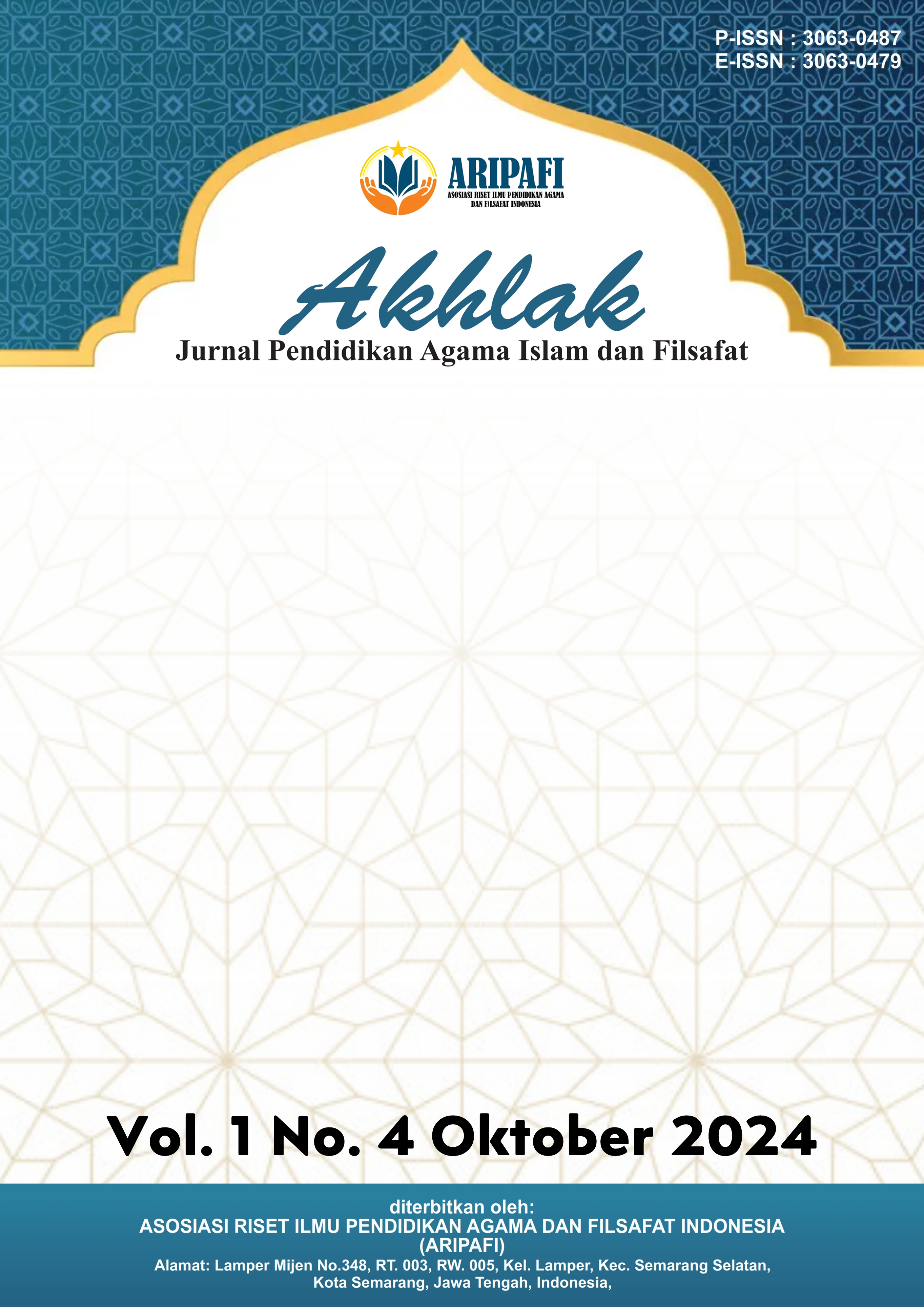Hubungan Interaksi Edukatif Terhadap Minat Belajar Siswa Kelas X pada Mata Pelajaran PAI di SMK N 1 Kinali
DOI:
https://doi.org/10.61132/akhlak.v1i4.122Keywords:
Educational Interaction, Interest in Learning, PAIAbstract
Researchers found in the field, students lacked focus in learning because the learning process was still teacher-centered, students played around and told stories while the teacher was explaining, students lacked the courage to ask questions and express opinions, there were still students who were late for class. during PAI subjects. So the problem discussed in this research is the relationship between educational interactions and students' interest in learning at SMK N 1 Kinali. The aim of this research is to find out how much educational interaction has a relationship with students' interest in learning at SMK N 1 Kinali. This research method is a correlation method with a quantitative descriptive approach. The population in this study was all class X students, totaling 413 students. Determining the number of samples used a random sampling technique using the Slovin formula, so that the sample obtained was 80 class X students. The data collection technique in this research was using a questionnaire technique. Before testing the hypothesis, the researcher first carried out prerequisite tests in the form of normality tests and linearity tests. Then continue with the hypothesis test using the product moment correlation test. The results of the research show that there is a relationship between educational interactions and the interest in learning of class X students in PAI subjects at SMK N 1 Kinali. The relationship between the two variables is classified as sufficient with a correlation value of 0.661. These results show that (0.661) > (0.219). So it was rejected and accepted, so it can be interpreted that there is a relationship between educational interactions and the interest in learning of class X students in PAI subjects at SMK N 1 Kinali.
References
Anhar, H. (2013). Interaksi edukatif menurut pemikiran Al-Ghazali. Jurnal Ilmiah Islam Futura, 13(1), 31. https://doi.org/10.22373/jiif.v13i1.570
Apriyani, R. (2022). Minat siswa terhadap mata pelajaran pendidikan jasmani kelas X SMA N 12 Kota Jambi pada masa new normal. Jurnal Of S.P.O.R.T., 6(1), 40-41. https://doi.org/10.37058/sport.v6i1.5022
Deswalantri, D., dkk. (2023). Faktor-faktor yang mempengaruhi prestasi belajar siswa Imapar Kota Bukittinggi. Jurnal Konseling Pendidikan Islam, 4(1), 91. https://doi.org/10.32806/jkpi.v4i1.242
Fahri, M. L., & Qusyairi, L. A. H. (2019). Interaksi sosial dalam proses pembelajaran. Jurnal Studi Keislaman dan Ilmu Pendidikan, PALAPA, 7(1), 150. https://doi.org/10.36088/palapa.v7i1.194
Fariyatul, E. (2016). Psikologi belajar mengajar, kunci sukses guru dan peserta didik dalam interaksi edukatif. Nizamia Learning Center.
Indah, E., Sirait, G. S., & Simamora, J. (2020). Analisis Undang-Undang Nomor 20 Tahun 2003 tentang sistem pendidikan nasional mencakup Bab IV Pasal 5 mengenai hak dan kewajiban warga negara, orang tua, dan pemerintah. Jurnal Visi Ilmu Sosial dan Humaniora (VISH), 1(1), 83.
Irfan. (2018). Pengaruh antara pola interaksi edukatif terhadap minat belajar siswa kelas X di SMA Negeri 1 Kota Bima. Jurnal Pendidikan Sosiologi, 1(1), 28. https://doi.org/10.33627/es.v1i2.29
Jelita, M., Ramadhan, L., Pratama, A. R., Yusri, F., & Yarni, L. (2023). Teori belajar behavioristik. Jurnal Pendidikan dan Konseling (JPDK), 5(3), 404-411.
Karisma, T., & Ega, D., dkk. (2022). Analisis minat belajar siswa pada pembelajaran kelas IV SDN Jleper 01. Jurnal Prasasti Ilmu, 2(3), 122. https://doi.org/10.24176/jpi.v2i3.8366
Komalasari, K. (n.d.). Pembelajaran kontekstual: Konsep dan aplikasi. Rafika Aditama.
Makhrus, A. M., Hariyati, T., Pratiwi, M. Y., & Afifah, S. (2022). Metodologi penelitian kuantitatif dan penerapannya dalam penelitian. Jurnal Education, 2(2), 2.
Nihayah, H. (2016). Konsep pendidikan Islam dalam perspektif Al-Quran surat At-Taubah ayat 122. Al Ulya: Jurnal Pendidikan Islam, 1(1), 33-34.
Prasetya, T., & Ningsih, T. (2023). Interaksi pendidikan dengan lingkungan sekitarnya. Garudhawaca.
Pratama, A. R. (2023). Contextual teaching and learning (CTL) dalam pembelajaran PAI di SDN 02 Percontohan. ALIFBATA: Journal of Basic Education, 3(2), 30-38. https://doi.org/10.51700/alifbata.v3i2.515
Pratama, A. R. (2023). Implementasi metode brainstorming dalam pembelajaran Pendidikan Agama Islam di kelas XI SMA Negeri 4 Bukittinggi. Madinah: Jurnal Studi Islam, 10(1), 120-130. https://doi.org/10.58518/madinah.v10i1.1496
Rizawati, dkk. (2017). Hubungan antara interaksi edukatif guru dengan hasil belajar siswa kelas VI SD Negeri 18 Banda Aceh. Jurnal Ilmiah Pendidikan Guru Sekolah Dasar, 2(1), 114.
Sahputra, N., & Napitupulu, D. (2019). Proses pembelajaran melalui interaksi edukatif dalam pendidikan Islam. Jurnal Tazkiya, 8(1), 134-136.
Susanto, A. (2012). Teori belajar dan pembelajaran di sekolah. Prenamedia Group.






